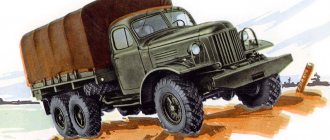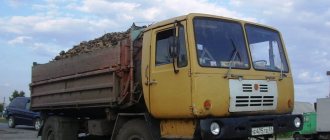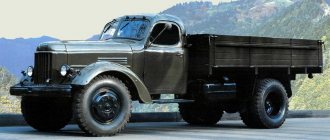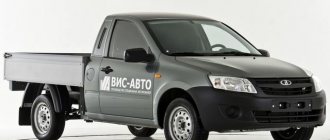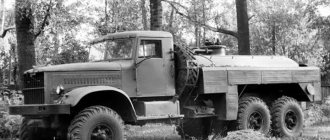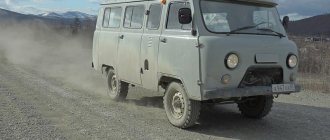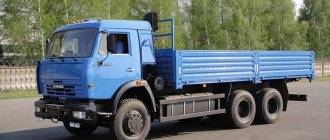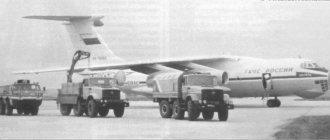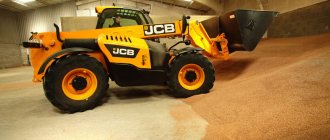Author: Lan, don’t growl
13 October 2015 13:37
Tags: ZIL ZIL 131 test drive
38429
32
It was not easy to drive this car right away. During my first visit to Andrey, the owner of the ZiL, the car was not drivable: the radiator was leaking. Standing in the rain, we agreed to meet a little later. I must admit, I was even a little happy: the weather was in no way conducive to photographing. But when we met again a few days later, the sun was shining, drying up the remnants of puddles and mud on the forest paths.
0
See all photos in the gallery
And again this didn’t suit me a little: I wanted to drive this “baby elephant” into a real wet, impassable mess and - I’ll tell you a secret - see where he could get stuck. We found the absence of a road and real Russian mud (no, not mud, mud!). But it was not possible to “plant” the car in it: the 131st ZIL is an excellent “rogue”. But a couple of dead wood trunks were still crushed, and the glass of the kung was broken. Which, in my opinion, is quite enough to evaluate the capabilities of this brave “warrior”. Go!
The party said: “We must!”
0
In the days from January 27 to February 5, 1959, the extraordinary XXI Congress of the CPSU was held in the meeting hall of the Supreme Soviet of the RSFSR, and the tasks assigned to the delegates this time were significantly different from those at many previous congresses. A seven-year plan for the development of the national economy was discussed, and its peculiarity was the variety of planned goals. This time we did not try with all our might to achieve one thing; we were talking about the comprehensive development of various sectors of the economy. It was at this congress that the historical thesis was announced that socialism had already been built, and it was time to take up communism. It’s not for us to judge whether this was the right decision, but the fact remains: it was necessary to build a bright future, but there was no suitable truck for this. The ZiS-150 is already quite outdated, and no matter how much they tried to modernize the ZiL-157, they still ended up with the ZiL-157 (a good car, by the way, it was put on the production line in 1958 and did not leave it until 1991, we will definitely ride one) . It was necessary to build something new. One of the delegates at the congress was A.G. Krylov is the director of the Likhachev Plant. The team of this enterprise was given the task of slowly replacing the ZIL-164, which had been produced for two years by that time, with the ZIL-130, and at the same time making an off-road truck based on it. The ZiL-130 in the modern sense did not yet exist, but the experimental ZiS-125, which later became the ZiL-130, was ready by 1957. The task, in general, was feasible. But with the 131st we still had to tinker a lot, because the main customer, as usual, was the Ministry of Defense, and this is already serious. Therefore, I will write the well-known stamp “the car saw the light” a little differently: the car saw the light in 1966. I saw it and was horrified. Especially the light that is overseas.
×
Owner reviews
Despite the many years of operation of the I. A. Likhachev plant, the cars are still in successful operation. The Internet is full of positive reviews, photos and videos of these machines; you can see a link to one of these stories here.
Since the first production of ZIL truck tractors in the amount of 100 units. By special order for Moscow, copies are repaired and operate at full speed.
Thanks to the versatility of all models, the plant easily took on the task of modernizing old machines and bringing them to a more modern look: the engine was changed, a new cabin was installed, the frame was completely disassembled and improved.
How to scare the capitalists?
0
There are two adjectives that can accurately and completely describe the appearance of the 131st ZIL. It's "big" and "green". According to the creators' ideas, it was also supposed to be a little beautiful, but the stern people in the uniform of the Soviet Army did not have such a fine mental organization to be imbued with respect for a complex-shaped radiator grille or stamped wings with smooth contours. They considered that straightening them in case of damage would take too much time and effort, and therefore advised to simplify some of the body elements. Let's give credit to the ZiL designers; they still managed, although they made the “tin can” simpler, to retain a certain amount of elegance. And only the slanted protective grilles on the car’s headlights make his look sad and say: “I could be more beautiful!” Don’t be sad, little elephant, you’re nothing at all for a military vehicle. Although it looks like a Studebaker from the early forties or an International Harvester, which, of course, is a pure coincidence. However, beauty is not the most important thing in a truck. It’s better to pay attention to the details visible to the naked eye.
0
The huge front bumper has corrugation on its upper platform. This is done for convenience, because only by standing on it can you reach the engine compartment; you cannot reach the engine compartment from the ground. But you can immediately see the orange “flashing light” on the roof, the retractable antenna on the kung and some other details. To explain these features of our truck’s configuration, let’s look at the history of its acquisition.
0
0
0
0
0
This ZIL spent his youth serving in the army. Then he ended up in one office, which we will not name, and only from there - into the hands of Andrei. It just so happened that even the exact year of production of this car could not be established (apparently a military secret), the exact mileage is also unknown: the speedometer and documents were replaced before the sale of the car. And Andrei needed the ZIL itself as a “technician”. The fact is that in addition to this truck, the car enthusiast also has another car, namely the Jeep Wrangler, which is actively used in racing. Just for the competition, a technical assistance vehicle was needed. Not every car can get to where a prepared Wrangler can go, so the choice fell on the 131st ZIL. In his kung you can easily transport a bunch of tools, a generator and a lot of other useful equipment. You can also carry people in the booth, because there is a “stove” there, and you can ride in relative comfort. Therefore, from time to time the car and its owner are contracted to work as a “shift” for people who need to drive into hard-to-reach places.
0
Since sometimes you have to drag a combat Wrangler along with you on a rigid hitch, an orange “flashing light” was installed, which proved to be much more reliable than the standard lights of a road train (these are three lights on the roof). An antenna is necessary for organizing communications: there is a GSM repeater in the kung, which allows you to stay in touch in the wildest places. Well, a winch will never hurt such a car. What other interesting things can you see outside? Probably nothing else significant. Except that there are two gas tanks on both sides of the car. Fuel consumption here is very decent: about 50 liters per hundred kilometers, so the tanks are appropriate - 170 liters each. Just for fun, let’s do the math: 170 x 2 = 340 liters. Let gasoline cost 34 rubles, then we get 11,560 rubles. And this is for one gas station. And, importantly, 650 kilometers along the route. However…
0
To be completely precise, the operating manual indicates a reference fuel consumption of 40 liters per hundred and a corresponding range of 850 kilometers. In fact, of course, everything is much worse. Let's see where all that gas goes. And it goes into an eight-cylinder V-shaped engine, the volume of which is almost six liters. But it produces only 150 horsepower. And if, thanks to the downshift in the transfer case, this truck moves quite well off-road, then on the highway the acceleration is not very impressive. But we are interested in off-road. Maximum power is achieved at maximum speed (3,200), and maximum torque of 410 Nm is available already at 1,800-2,000 rpm. For those who have been staring for several minutes in the hope of finding at least a little bit of cast iron and aluminum data, we inform you: the cylinder block here is cast iron, with “wet” liners, but the cylinder heads (there are two of them) are cast from an aluminum alloy. The steel camshaft is driven by gears and operates the valves (they are on top) through pushrods, rods and rocker arms.
0
The gearbox is five-speed, and all gears except the first have synchronizers. There is, of course, a transfer case with two gears. We will consider the subtleties of the joint work of the ZiL gas guzzler and transmission units a little later. Now let’s sit in the cockpit and from there look at the pressure gauge and find out why this particular device can be called the most important in ZIL.
Truck Specifications
The technical characteristics of the ZIL 131 helped it gain such popularity, which the model retained for many years. To understand the features of this machine, it is necessary to consider each part separately.
Engine
The carburetor engine of a truck is distinguished by high power and excellent technical characteristics:
| engine's type | ZIL-5081 |
| Number of bars | Four |
| Cylinders | Eight pieces |
| Features of cylinder placement | Right angle, V-shaped |
| Cylinder size | Diameter 100 mm |
| Piston stroke | 95 mm |
| Capacity | 5.97 l |
| Compression level | 6,5 |
| Power | 110.3 kW (150 hp) |
| Torque | 410 Nm |
| Maximum speed development possibilities | 85 km/h |
| Type of cooling | Liquid |
| Recommended fuel | Gasoline A-76 or with a higher octane number |
| Average fuel consumption | 35 l/100 km |
Transmission
The transmission had the following characteristics:
| Type of clutch | 24 |
| Transmission | 182EM/6ST-132EM |
| Rear axle drive | Pass-through serial |
| main gear | Double |
| Gear ratio | 7,339:1 |
A distinctive feature of the ZIL 131 is access to only two rear axles. The front one is switched on automatically. For this purpose, the car has an electro-pneumatic drive in its design.
Electrical system
The ignition system in this model has been significantly improved. It is shielded, sealed, non-contact transistor, which ensures effective operation in any conditions. All electrical appliances operate from one 12 V battery and an alternator with a large power reserve.
Sealed shielded ignition system
Suspension
The suspension is located at the front. It operates on two springs. Shock absorbers are included in the design of the truck. The rear suspension is balanced, with six bars. The brakes operate using drums, pneumatics and a mechanical drive.
ZIL-131 with air suspension
In the belly of ZiL
0
Despite the decent height, it’s not difficult to climb into the ZIL’s cabin: the handles were under my palms exactly at the moment when I just started to fall, slipping on the metal step. Thanks to them, I still get to the driver's seat of the truck and begin to study the instruments and controls.
0
The first thing we pay attention to is the number of information signs and brief instructions. This was done so that an eighteen-year-old warrior who was drafted here would not immediately go crazy and ruin himself and a piece of equipment. It is interesting that they all address the driver first name, while the operating manual uses constructions such as “the driver must”, “it is necessary for this” or simply “should”. Apparently, the authors quite rightly reasoned that the signs would be read by an ordinary soldier, and the leadership by an officer. Or maybe they were simply saving space on the signs: “turn on” or “close” are written shorter than “turn on” or “close.”
0
0
The instruments are located quite conveniently, and their readings can be read without difficulty. Most of them are familiar to almost any car enthusiast. These are a speedometer, ammeter, coolant temperature, oil pressure and fuel level indicators. The leftmost scale is an indicator of the air pressure in the tires; fortunately, you can deflate or inflate the tires right there: under the device you can see the lever of the valve for controlling this pressure. When driving through swampy places, you can reduce the pressure to only 0.5 kgf/cm2, and on the highway - raise it to 3.5-4. And do it right on the go. The main thing is not to waste too much air! Let's explain why.
0
0
0
0
0
Remember, I said that the most important device on the ZIL panel can be considered a pressure gauge? So, a lot depends on the operation of the pneumatic system, and first of all, the braking system. Here it is pneumatic, not hydraulic, as on most modern passenger cars. The pressure gauge is a two-pointer, its upper part shows the pressure in the air cylinders of the brake system, and the lower part shows the pressure directly in the brake chambers. Cylinder air is used for more than just brakes. It is necessary for inflating tires, for connecting the front axle (it is forcibly connected by a lever from the cab using an electro-pneumatic valve), for a pneumatic sound signal (although there is also an electric one), for driving the windshield wiper blades. But the pressure should never fall below 4 kgf/cm2. As soon as the pressure drops below six, the compressor raises it to 7.3-7.7 kgf/cm2, after which air again begins to be consumed from the cylinders. Everything, in general, is not bad, if not for one “but”: the brakes are designed in such a way that if the pressure drops critically (for example, if a compressor breaks down), they simply fail. It becomes impossible to stop a car whose total weight with cargo can exceed ten tons. There is a parking brake, and it’s not pneumatic, but you can’t stop a heavy truck with it alone. Therefore, the driver has to look at the road with one eye, and with the other, look at the pressure gauge, so that if something happens, he has time to notice an abnormal drop in pressure in the pneumatic system.
0
The main controls are conveniently located. The steering wheel, however, is a bit big, but considering that there is a hydraulic booster, it is very easy to turn it. The pedal assembly was slightly changed: tired of struggling with the gas pedal pulls, Andrey installed the pedal and drive from Mazda. Therefore, now the picture of the pedal assembly looks funny: the harsh clutch pedal goes to the floor, the huge brake pedal is on the floor, and the gas pedal from Mazda suspended from above looks next to them like a college girl in a demobilization car.
0
The gear shift pattern is strange at first glance - the second gear is in the place of the first, and the first is to the right and back, opposite the rear, but this is logical: usually you can start from the second gear. It is interesting that on the knob of the lever there is a diagram on which the rear is indicated simply by an arrow, and not by the more familiar Soviet abbreviation “ЗХ” (“reverse”). But that's it, it's time to go.
A few words about the cabin and body
The ZIL-131 cab is hooded, all-metal. The interior is made in a harsh Soviet style, without “bourgeois” frills, but with all the necessary functionality. There is thermal insulation, lighting, and an electronic instrument panel. Number of seats - three. The driver's seat and 2 passenger seats are separate, which makes it possible to adjust them independently. The suspension under the cabin is rigid, so it will always shake. If we talk about access to the engine, then in the hooded cabin this is not a problem - you just need to lift the hood lid.
Cabin ZIL 131
The sides of the body are wooden, solid. Loading is carried out through a folding tailgate. If necessary, metal arches are mounted on the body, over which a protective awning is stretched. There are folding benches on the sides for transporting personnel. The set includes a removable bench for 8 people. In total, 24 seats can be arranged in the body.
Body ZIL 131
Let's hit the ZIL off-road!
0
In front of us, a second-generation Cherokee is climbing along the forest path, and I’m following behind in a ZIL. And you know, this rather large jeep walking in front of me seems like a small insect. My task is not to accidentally crush this insect. Avoid potholes and puddles? What for! Moreover, on this narrow road it was not so easy for me to even hold the truck. The steering wheel play, even according to the passport, can reach 25 degrees. And taking into account the fact that the car is crawling on a washed-out road and scraping it with three drive axles, control becomes a difficult thing. At least not without proper experience. Having reached the place where Cherokee wisely stopped, we move on. Even in second gear, the ZIL creeps along slowly and is already asking to put it in third. And all because the low gear was turned on, because, in general, there was no road anymore. A light on the panel lights up, indicating that the front axle is connected. On the way, I manage to appreciate the need for hatches in the cabin roof: with the side windows down, it’s very easy to get hit in the face with a tree branch. This is where you have to close the windows and open the hatches: there is fresh air, but there is no threat of getting hit in the face by a vengeful birch or aspen. However, here it is, the first obstacle: trees lying across the road. I even managed to get upset: how could it be, we just started! But, as it turned out, a pair of guns for a ZIL are matches. He moved and barely twitched. True, I had to engage first gear.
0
0
By the way, about switching. This lever could probably easily kill a person. The seating position in the car is high (otherwise you simply won’t see anything because of the huge hood), so the gearshift lever is very long. The move is expected to be large, but this is not the main thing. The trick is that the speed is switched on almost immediately, there is no need to miss or stick into gear with effort and grinding. Except, perhaps, the first one. But here the dog is buried, as I think, in the absence of a synchronizer in this gear. ZiL can be forgiven for such a trifle. When turning on the patch, we very successfully drove the rear axles into a small ravine. The axles stood at an unnaturally large angle, but our “baby elephant” made no attempt to lie on its side. He stood obediently, bending over like a barn cat trying to catch a flea on its own scruff. The only thing that was damaged was the glass of the kung, which apparently was broken on a thick tree branch, or maybe even on a trunk. I didn't have to take a photo of the truck lying on its side, which is good. Well, we sat behind the wheel, we were shocked in the passenger seat, it’s time to ride in the kung.
0
0
0
Kung. What a strange word. Have you ever wondered where it came from? Some may think that this is some kind of borrowing from a foreign language, but this is not so. “KUNG” is an abbreviation for “uniform body of zero (normal) dimensions.” And this term appeared just here, or rather, in the army. The first kungs were installed on ZIL-157 and 131, and then on GAZ-63, GAZ-66, KAMAZ-4310, Ural-375. What’s good about a kung is that it’s more pleasant to drive in than in an open body or under a regular tarpaulin. There is no heating, no wind, sit and enjoy. But it was not there. On any decent bumps (and we drove over a lot of them), the kung is thrown from side to side. You have to grab onto everything that is more or less motionless, rest your feet on the floor and protect your head. I didn't like it there at all. Although, I think, at minus twenty-five I would have climbed there with pleasure, so usually a kung gun is an irreplaceable thing.
0
0
What can be changed?
Tuning a ZIL car (photos of which can be seen in this article) most often consists of the following steps:
- Frame reinforcement.
- Engine replacement.
- Interior improvements.
- Increased comfort.
This is a fairly general list of work performed. More specific methods depend on the desires and capabilities of the car owner. In addition, it is necessary to start from the truck model, which must undergo tuning. Let's take a closer look at three of them: ZIL-130, ZIL-131 and ZIL-5301.
Upgrade level
Tuning may include a varying number of modifications performed. Depending on this, there are three degrees:
- Cosmetic - minor changes, which consist of installing additional elements (headlights, visor, moldings, radiator grille, guardrail, etc.), painting the body and its airbrushing, equipping it with a modern audio system.
- Medium - aimed at increasing the level of comfort in the cabin, improving the exhaust system, transmission and other individual parts of the engine.
- High - in addition to the work already described, the technical characteristics of the truck are improved (fuel consumption, power, handling, speed, etc.).
These modifications may apply to any of the models.
